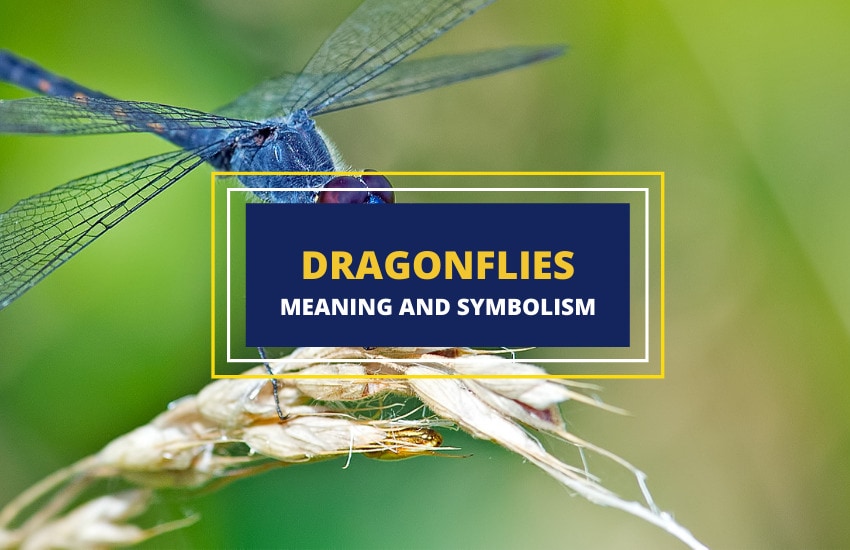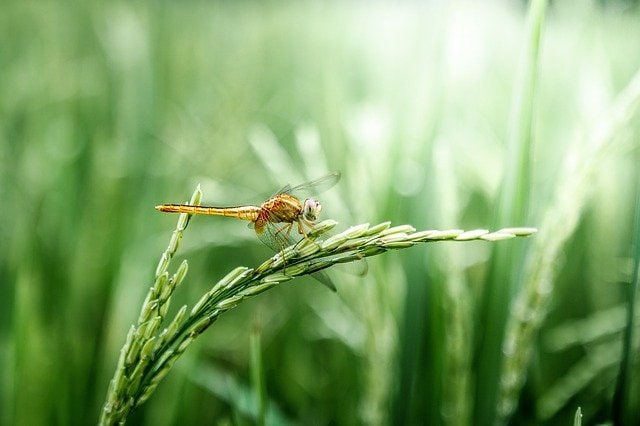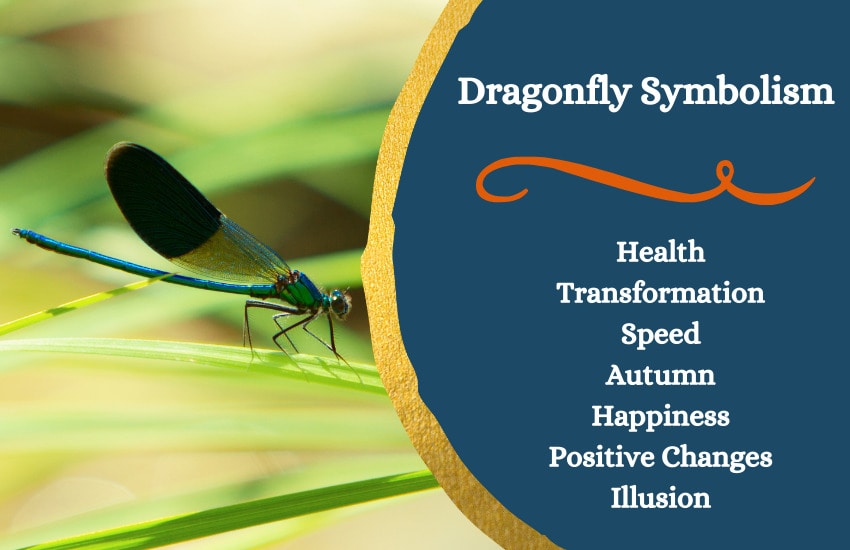
Table of Contents
Dragonflies are best known for their exceptional flying skills, so much so that engineers have been studying them to find ways of building robots that will imitate these flying skills. This, however, is not the only interesting thing about dragonflies. There are many facts and myths about these magnificent insects, as well as surprising meanings that they’re associated with.
What Are Dragonflies?

Belonging to the Epriprocta suborder of the Odonata order, dragonflies are predatory, water-loving insects with strong transparent, patched wings, elongated bodies, and big multifaceted eyes that can see from all angles except right behind them.
They are agile flyers and can fly straight up or down, and even mate mid-air. Dragonflies are major predators in both their nymph phase and adult phase. As adults, they only catch and feed on flying insects, and are nature’s way of controlling annoying mosquitoes. What’s most interesting about dragonflies is that while their nymphal phase can last up to five years, an adult dragonfly lives only between five weeks to ten weeks.
With nearly five thousand species across the world, dragonflies have held a part in the world of humans for centuries, and are represented in artwork like statues, pottery, jewelry, and rock paintings. Moreover, they are a delicacy in Indonesia and a source of traditional medicine in China and Japan.
What do Dragonflies Symbolize
Dragonflies are viewed differently depending on the area and specific culture. For instance, while they are seen as sinister creatures in most European countries, in Eastern countries they are associated with numerous good aspects. Below are some of the symbolic meanings of dragonflies.
- Health – This meaning has its roots in Native American culture whereby tribes like the Pueblo, Hopi, and Zuni saw dragonflies as healers who especially had the divine responsibility to heal injured snakes. These tribes, in fact, referred to them either as ‘healing animals’ or as ‘snake doctors’.
- Autumn – The Japanese have come to associate dragonflies with autumn, mainly because that is the time they are sighted in plenty.
- Transformation – Dragonflies live in water as nymphs for most of their lives before transforming into elegant flying insects who then leave the water and enjoy the free air for a few weeks before dying off. Because of this, they have come to represent transformation in lots of cultures.
- Speed – This is derived from ancient Egypt where warriors would have dragonfly tattoos on their bodies out of admiration for their charisma and speed.
- Happiness – Because they only get a short time to be flying insects, dragonflies make good use of their short lives as adults. They use their new radiant wings to dance around with happiness and freedom. Because of this, they have become symbols of living life to the fullest and living in the moment.
- Positive Changes – This symbolism is borrowed from the Chinese who use dragonfly statues and other artwork in the practice of Feng Shui believing that they have the power to attract good tidings.
- Illusion – This has its roots in the Native American myth that holds that dragonflies were once big dragons that were tricked into shapeshifting by a coyote and never managed to shift back.
- Evil injury – This symbolic meaning is conversant with European cultures that believe them to be sinister. They have thus been branded with titles such as “horse- stingers”, “ear cutter”, and ‘devil’s darning needle’. In addition, the Swedish believe that dragonflies are the devil’s agents sent to weigh people’s souls.

Dragonfly Tattoo Meaning
Generally, dragonfly tattoos signify happiness, positivity, and transformation. The meaning of dragonfly tattoos, however, varies based on the culture within which they’re viewed.
- For Australian Aboriginals, a dragonfly tattoo is a representation of freedom and enlightenment. It’s also chosen to mean that the specific person has received spiritual awakening.
- When chosen by a warrior or a fighter, a dragonfly tattoo represents speed, power, courage, and agility
- In Asian countries, they represent harmony, prosperity, and good luck.
- For Native Americans, dragonfly art represents happiness, purity, and speed. Additionally, when drawn as a vertical line, a circular head, and two horizontal lines crossing the body, they then become a representation of communication between the seen and unseen realms.
- The Japanese pick dragonfly body art as a symbol of agility, speed, and power. The Samurai see it as a symbol of victory.
- The Celts draw the dragonfly tattoo as a symbol of imagination, insight, and clear vision. This group draws their tattoos with intricate angular patterns and interlocking knots or spirals in varying colors
- In the New Age, dragonfly tattoos are a representative of spiritual awakening and growth.
Stories and Myths about the Dragonfly
In Buddhism, it was believed that during the Bon festival in mid-August, ancestral spirits visited the living while riding dragonflies. During this period, catching dragonflies is prohibited and they are instead welcomed into the house for a temporal get-together.
The Ancient Welsh believed that dragonflies are servants to snakes and follow them around feeding them and healing their injuries.
The Japanese tell the Legend of Jimmu Tenno, a descendant of the sun goddess Amaterasu, and the first emperor of Japan, saw the resemblance between the Honshu and dragonflies and thus named it the Dragonfly Island.
Native Americans used dragonflies to predict rain. Seeing them flying high meant that it would rain heavily while seeing them flying low meant that it would rain lightly. Dragonflies in this culture also predict fishing success if they land on the fishing pole.
In Lowa, Dragonflies were seen as very sly creatures who sewed together the fingers and toes of anyone who dared sleep outside.
The Germans have a not-so-rosy myth about the origin of the dragonfly. The myth tells that one day, a malicious princess was happily riding her horse when she came across a little man. She warned him to get out of her way, but the man refused to heed the warning. The princess rode over him causing the little man to curse her to always be one with her horse, which in turn caused her to transform into a dragonfly.
Ancient Romanians believed the dragonfly to be the devil himself. According to this myth, the devil had to transform into a dragonfly to cross a mighty river because a fisherman had refused to let him ride his boat. Luckily, his denial is how we got these mosquito slayers.
Wrapping Up
No matter the symbolic meaning you subscribe to, what we know for certain is that dragonflies are excellent in controlling mosquitoes and gnats, both pests we are happy to be rid of. Their beautiful colorful wings and characteristics make them the perfect representations of a variety of symbolic meanings.





